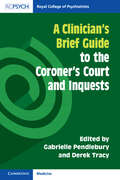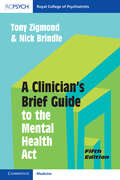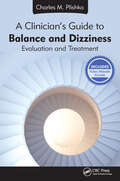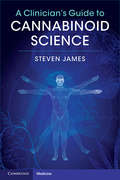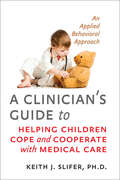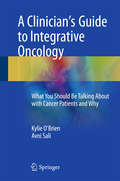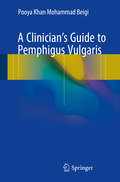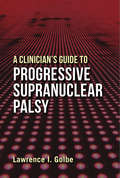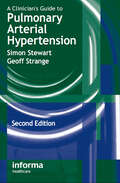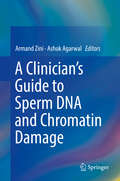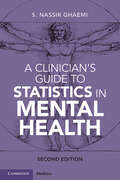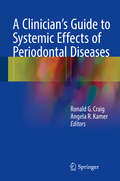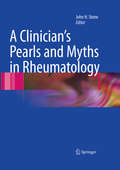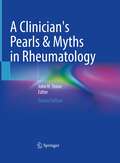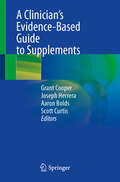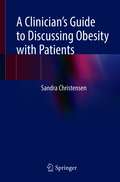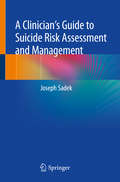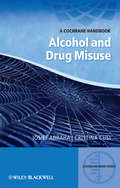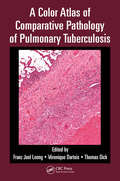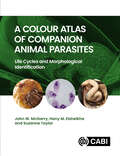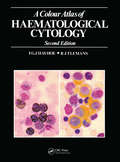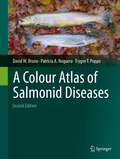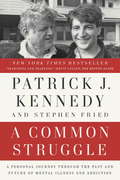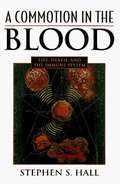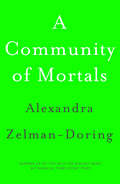- Table View
- List View
A Clinician's Brief Guide to the Coroner's Court and Inquests (A Clinician's Brief Guide)
by Gabrielle Pendlebury Derek TracyThe sudden and unexpected death of a patient can be emotionally complex and overwhelming for clinicians. This book will equip medical and other healthcare professionals with the necessary information and skills to fulfil their requirements in the coroner's court confidently and competently and understand their organisation's responsibilities. Practical and straightforward, this book aims to make the unfamiliar territory of the coroner's court transparent, enabling clinicians to negotiate all eventualities. It will provide clinicians with the confidence to turn what can feel like an adversarial situation into an opportunity to engage with an important part of the healthcare system, preventing future deaths and providing understanding to relatives. It also explores the underlying necessity of complying with requirements and suggests ways to cope with the emotional impact. With chapters covering expert witnesses, legal perspectives and managing outcomes, this book is essential for any healthcare professional called to an inquest.
A Clinician's Brief Guide to the Mental Health Act (A Clinician's Brief Guide)
by Tony Zigmond Nick BrindleA 'how to' book guiding clinicians through the mental health legislation that they need to understand and use in their daily practice, covering the Mental Health Act 1983 and subsequent amendments. This revised and updated edition incorporates new acts, such as the Policing and Crime Act 2017 and Mental Capacity (Amendment) Act 2019. It also covers the findings and implications from Professor Sir Simon Wessely's 2018 review of the Mental Health Act in a new chapter. Written by two leading psychiatrists with many years of experience in using the mental health legislation and in running mental health law courses, this book outlines how changes to statutes and case law have a direct bearing on day-to-day psychiatric practice and why it is important that clinicians of all disciplines have access to and understand the legislation. This is the go-to guide for all clinicians, doctors and nurses working in mental health services.
A Clinician's Guide to Balance and Dizziness: Evaluation and Treatment
by Charles M. PlishkaWith an increasing number of referrals to treat balance impairment, gait disorders, and dizziness, A Clinician’s Guide to Balance and Dizziness: Evaluation and Treatment by Dr. Charles M. Plishka looks to address these issues and provides tests, measures, and interventions that are matched to research studies when available, for evidence-based practice. It begins with a review of the anatomy and physiology of the systems used to balance. With a basic understanding of how we balance, the signs and symptoms of patients will be understood with much greater ease.A Clinician’s Guide to Balance and Dizziness enables the reader to perform a complete and thorough evaluation and helps to provide treatment options for identified deficits that place the patient at risk for falls. Along with numerous diagrams and photos, this text comes with access to a web site containing video clips that demonstrate key evaluation and treatment techniques. The result will be a better evaluation, treatment plan, and outcome.Topics and Features Include: How do we balance? Tests to evaluate the balance-impaired patient Tests and interventions for conditions such as Benign Paroxysmal Positional Vertigo (BPPV), Vestibular Loss, and the central and peripheral causes of dizziness Therapy treatments “How to” instructions throughout Companion web site with video clips demonstrating evaluation and treatments A Clinician’s Guide to Balance and Dizziness: Evaluation and Treatment is an easy-to-use reference perfect for professionals who assess and treat balance impairments and dizziness. While it is an instructional text for physical therapy students and clinicians, it is also a great reference for established physicians, vestibular and balance therapy specialists, occupational therapists, nurse practitioners, physician assistants, audiologists, and athletic trainers.
A Clinician's Guide to Cannabinoid Science
by Steven JamesMedical marijuana and the promise of medical advances with cannabinoids is a controversial topic. This book provides clinicians with credible, peer-reviewed science to advise patients on the use of cannabinoids in practice. From the history of cannabis to the recent discoveries, chapters include the science of cannabinoids, changes in the legal and regulatory landscape, and the emerging area of endocannabinoids. The book differentiates approved cannabinoids from cannabis and medical marijuana and stimulates clinicians to think about the risks and benefits of these two drugs. It provides the factual background for clinicians to lead the discussion on the continued use of marijuana, ongoing areas of research and future advances and development of new medications for treatment. An invaluable guide for all specialists in the pharmaceutical sciences, toxicologists, biochemists, neurologists, psychiatrists, addiction specialists, as well as primary care physicians, nurse practitioners, and regulators and policymakers.
A Clinician's Guide to Helping Children Cope and Cooperate with Medical Care: An Applied Behavioral Approach
by Keith J. SliferHow adults can help children cope with routine and traumatic medical care.Keith J. Slifer, a pediatric psychologist at the Kennedy Krieger Institute and the Johns Hopkins University School of Medicine, explores how adults can help children cope with routine and traumatic medical care. He draws on practice and research to help health care practitioners provide better care for children with chronic conditions and children undergoing rehabilitation after traumatic injury or surgery. By better understanding the behavior, emotions, and developmental challenges of children, health care professionals in practice and in training can solve a range of problems, from getting a distressed child to cooperate with a physical examination or diagnostic test, to teaching a child to adhere to medical self-care.More than 9 million children in the United States regularly visit health care professionals for treatment of chronic or recurrent health conditions. These children experience multiple doctors’ visits, trips to the emergency department, hospital admissions, anesthesia, surgery, medications, needle sticks, wound cleaning, seizures, nausea, vomiting, pain, and fear. While most of these children are developing typically in terms of their intellectual and cognitive functioning, many children with intellectual, developmental, and physical disabilities also require frequent medical care, and as chronic health conditions increase, so do the chances of having developmental, learning, emotional, and behavioral problems.A Clinician's Guide to Helping Children Cope and Cooperate with Medical Care will benefit health care professionals and children as practitioners aim both to improve medical care and to prevent the children’s behavior from disrupting clinics and distressing and frustrating health care workers and family caregivers. This book is for pediatric psychologists, pediatricians, family medicine practitioners, physician’s assistants, nurse specialists, pediatric subspecialists, and students in these fields—and for family members dedicated to helping their children cope with medical procedures and to getting the best possible medical care.
A Clinician's Guide to Integrative Oncology: What You Should Be Talking About with Cancer Patients and Why
by Kylie O'Brien Avni SaliThis book is the definitive guide for oncologists, general medical practitioners and other healthcare professionals with an interest in integrative oncology. Guiding you on how to conduct the "ultimate consultation" from an integrative medicine perspective, this text is a valuable educational tool, presenting the latest evidence-based approaches to managing the cancer patient, as well as anecdotes and practical recommendations from Dr. Sali's decades of clinical experience as a leading expert in integrative oncology. Topics include the role of mind-body medicine in cancer, stress reduction, diet, sleep, sunshine and Vitamin D, exercise, vitamins and other supplements, supportive complementary medicines including Chinese herbal medicine and acupuncture, and innovative investigative and treatment technologies. Written by two clinicians who are also educators and researchers, A Clinician's Guide to Integrative Oncology provides practical, evidence-based information and patient advice that clinicians can put into practice immediately.
A Clinician's Guide to Pemphigus Vulgaris
by Pooya Khan Mohammad BeigiGiving dermatologists, dermatology residents, and primary care physicians a deeper insight into pemphigus vulgaris, a rare autoimmune disease characterized by blisters and lesions on the skin and mucous membranes, this book provides insight and treatment options alongside dozens of high quality photographs, pathology slides, illustrations, algorithms, figures and clinical tables detailing the disease at all stages. Providing more than 20 clinical case photos of patients exhibiting symptoms, A Clinician's Guide to Pemphigus Vulgaris summarizes much of what is known about this disease, including categories of the disorder, clinical symptoms, diagnosis and treatment, and recent clinical research photos about the disease.
A Clinician's Guide to Progressive Supranuclear Palsy
by Lawrence I. GolbeThis brief, clinically-focused volume is informed by Lawrence I. Golbe’s three decades of research and tertiary clinical care in progressive supranuclear palsy, a complex disorder with rapidly changing diagnostic and therapeutic approaches. It is an ideal source for the general neurologist seeking a refresher and the primary care provider, neurological nurse, or physical, occupational or speech therapist who must address their patients’ specialized needs. A Clinician’s Guide to Progressive Supranuclear Palsy emphasizes early diagnostic signs, medication options, non-pharmacologic management and palliative care. It offers a quick overview of the complications of PSP most likely to prompt an ER visit; a widening spectrum of PSP variants; and ample description of the genetics, epidemiology, natural history, pathology, molecular biology and neurochemistry of PSP. The PSP Rating Scale used in the book is a convenient tool for clinicians in routine practice and the leading PSP clinical measure world-wide. Golbe provides a practical and useful guidebook to help all clinicians learn and battle this complex disorder.
A Clinician's Guide to Pulmonary Arterial Hypertension
by Simon StewartPulmonary arterial hypertension (PAH) is a relatively rare but potentially life-threatening disease. In most forms, the disease is likely to be diagnosed late and is associated with progressive clinical deterioration and premature death. A Clinician's Guide to Pulmonary Arterial Hypertension, Second Edition enhances the overall PAH awareness of the
A Clinician's Guide to Sperm DNA and Chromatin Damage
by Ashok Agarwal Armand ZiniThis comprehensive, up-to-date text, which brings together the key practical elements of the rapidly evolving field of sperm DNA and chromatin abnormalities, is divided thematically into five main sections. Part I discusses human sperm chromatin structure and nuclear architecture, while part II presents laboratory evaluation of sperm DNA damage, including SCSA, SCD, TUNEL and Comet assays, and cytochemical tests. Biological and clinical factors in the etiology of sperm DNA damage are discussed in part III, including oxidative stress, abortive apoptosis, cancer, and environmental and lifestyle factors. Part IV presents clinical studies on the utility of sperm DNA damage tests, both with natural and ART-assisted pregnancies, and debates the clinical utility of such tests. Finally, part V discusses current treatment options, such as antioxidant therapy, varicocelectomy, advanced sperm processing techniques and the use of testicular sperm. We are now beginning to better understand the unique organization of the sperm chromatin, as well as the nature and etiology of sperm DNA damage. Written and edited by worldwide experts in andrology, A Clinician's Guide to Sperm DNA and Chromatin Damage is an excellent resource for reproductive medicine and REI specialists, urologists, reproductive biologists and any professional working with the infertile male.
A Clinician's Guide to Statistics in Mental Health: Measuring Truth And Uncertainty
by S. Nassir GhaemiThe second edition of a clear and accessible guide to the application of statistics in psychiatric practice. The book expertly describes statistical concepts in clear and simple terms, with minimal mathematical content, making it the ideal resource for busy mental health professionals. Fully revised throughout, it features five new chapters covering key advances in the field and important topics in greater detail. Amongst the key concepts discussed in this edition are the logic of randomization, clinical trials, the overuse of p-values, understanding effect sizes, meta-analysis and why clinical experience is limited by observational confounding bias. Featuring a wealth of clinical examples, on topics of high importance or controversy in psychiatry, plus explanations and reasoning, to give clinicians a better understanding of how to apply research to their practice.
A Clinician's Guide to Systemic Effects of Periodontal Diseases
by Ronald G. Craig Angela R. KamerA Clinician's Guide to Systemic Effects of Periodontal Diseases will serve as an ideal, easy-to-use reference for the practicing health professional. It summarizes the latest research on the systemic effects of periodontal diseases, discusses how the results of this research will impact on clinical practice, and aims to help the clinician to answer questions that may be posed by patients, medical colleagues, and the media. A central theme is the contribution of periodontal diseases to systemic inflammation but other mechanisms, such as systemic dissemination of oral pathogens, are also covered. A collaborative approach involving noted investigators in each field and medical colleagues ensures that all chapters are of clinical relevance from both a dental and a medical perspective. The book is also visually engaging, with numerous summary figures and graphics, bullet point tables, and highlight boxes identifying the most clinically significant points.
A Clinician's Pearls & Myths in Rheumatology
by John H. StoneImportant strides have been made in understanding the pathophysiologic basis of many inflammatory conditions in recent years, but rheumatology remains a discipline in which diagnosis is rooted in the medical history skillfully extracted from the patient, the careful physical examination, and the discriminating use of laboratory tests and imaging. Moreover, selection of the most appropriate therapy for patients with rheumatic diseases also remains heavily reliant upon clinical experience. Medical disciplines such as rheumatology that depend significantly upon clinical wisdom are prone to the development of systems of 'Pearls' and 'Myths,' related to the diseases they call their own, a 'Pearl' being a nugget of truth about the diagnosis or treatment of a particular disease that has been gained by dint of clinical experience and a 'Myth' being a commonly held belief that influences the practice of many clinicians - but is false. This book will pool together the clinical wisdom of seasoned, expert rheumatologists who participate in the care of patients with autoimmune diseases, systemic inflammatory disorders, and all other rheumatic conditions.
A Clinician's Pearls & Myths in Rheumatology
by John H. StoneThis book builds upon the first edition with new and improved chapters. The book explores the rich assemblage of clinical wisdom from expert rheumatologists from a wide range of specialties including Vasculitis and Sjogren’s syndrome. It examines the nuggets or ‘pearls’ of wisdom gained from collective clinical experience about the diagnosis or treatment of various diseases whilst also aiming to debunk myths that have influenced the practice of rheumatology by many clinicians. The second edition of A Clinician's Pearls and Myths in Rheumatology is a critical resource for both practitioners and students of rheumatology. This book provides a clear guide for those wishing to take a “deep dive” into the diagnostic and therapeutic elements of rheumatology.
A Clinician’s Evidence-Based Guide to Supplements
by Grant Cooper Scott Curtis Joseph Herrera Aaron BoldsNutritional supplements are ubiquitous. A physician may be asked 10-20 times a day about various supplements. That same physician ends up relying primarily on the internet for information about the supplements. Currently, there is no single, easy-to-use reference for a physician to access to learn about the evidence behind different common supplements. This text fills that gap by allowing physicians to be able to educate themselves and their patients about important supplements in terms of what the data actually says about those supplements, how they work or don't work on different problems and also how those supplements may interact with a patient's medications.The chapters are organized alphabetically by supplement to make it easy for a physician to reference which one they are specifically looking for. There are eight chapters total as well as an introduction and conclusion. Each supplement is broken down into subsections such as what is it and howit works in the body, what is it used for and at what dosage, evidence for or against its different uses, safety concerns, side effects, and precautions and interactions with other medications. Written by experts in the field, An Evidence-Based Guide to Supplements appeals to practicing physicians of every specialty that interact with patients. Supplements are asked about in almost every medical office but especially with primary care physicians, neurologists, psychiatrists, pediatricians, geriatric medicine professionals, pain medicine specialists and rheumatologists.
A Clinician’s Guide to Discussing Obesity with Patients
by Sandra ChristensenThis practical book provides effective, time-efficient strategies for initiating and continuing productive conversations about weight that can be incorporated into any practice setting. It will benefit all clinicians—advanced practice nurses, physician assistants, physicians—from students to experienced providers, whether they provide obesity treatment or refer to those who do.This guide addresses the numerous barriers that clinicians encounter when they contemplate or attempt conversations about weight and provides strategies to reduce and overcome these barriers. It guides clinicians step-by-step through the concepts and skills needed to have conversations that lead to improved health. Each chapter provides useful tools and information about how to move the conversation forward in a respectful, skillful manner. Real life clinical scenarios provide examples of short, productive conversations that incorporate the tools into clinical practice. Many clinicians recognize the importance of discussing weight with their patients yet feel unprepared to do so. Most did not learn about obesity or how to talk about it in their clinical educational programs and have little access to continuing education. Without the knowledge and skills to start a productive conversation, many avoid the topic. This avoidance has a negative impact on the health of those with obesity and pre-obesity. Given that obesity treatment improves outcomes, it is imperative that clinicians are skilled at discussing weight with knowledge and sensitivity. This book meets that gap.
A Clinician’s Guide to Suicide Risk Assessment and Management
by Joseph SadekThis book offers mental health clinicians a comprehensive guide to assessing and managing suicide risk. Suicide has now come to be understood as a multidimensionally determined outcome, which stems from the complex interaction of biological, genetic, psychological, sociological and environmental factors. Based on recent evidence and an extensive literature review, the book provides straightforward, essential information that can easily be applied in a wide variety of disciplines.
A Cochrane Handbook of Alcohol and Drug Misuse
by Cristina Cusi Iosief AbrahaAddiction to drugs and alcohol is an increasing problem that all clinicians have to deal with. This Cochrane Handbook of Alcohol and Drug Misuse serves as a concise guide to the evidence base for relevant interventions, highlighting the key points of Cochrane reviews for the busy practitioner. It covers a wide range of pharmacological and psychosocial treatments for opioid, alcohol, cocaine and other stimulant and drug misuse, offering comprehensive coverage of interventions for drug and alcohol addiction.
A Color Atlas of Comparative Pathology of Pulmonary Tuberculosis
by Franz Joel Leong Véronique Dartois Thomas DickAn annual death toll of 2 million, coupled with rising drug resistance, highlights the need for the development of new drugs, better diagnostics, and a tuberculosis (TB) vaccine. Addressing these key issues, A Color Atlas of Comparative Pathology of Pulmonary Tuberculosis introduces TB histopathology to the non-histopathologists, students, scientis
A Colour Atlas of Companion Animal Parasites: Life Cycles and Morphological Identification
by John McGarry Hany Elsheikha Suzanne TaylorA Colour Atlas of Companion Animal Parasites: Life Cycles and Morphological Identification illustrates how to identify common parasites of dogs, cats and horses using simple morphological features. It presents parasite life cycles in straightforward, accurate terms, and covers: - the general features of major arthropods, helminths and protozoa of dogs, cats and horses; - morphological identification of both adult parasites and their immature stages in tissues, with particular consideration given to differential identification; - major parasites of companion animals which may shift regions because of climate change, animal movement and other anthropogenic factors. Parasite identification is fundamental, not only for planning treatment, prevention and management of parasitic disease, but also for surveillance of invasive exotic parasites and for monitoring the spread of endemic species. With 600 parasite specimens photographed and annotated as a quick reference resource, this book mirrors what a practitioner might view down a microscope, bringing the subject alive. It forms a complete and practical resource for all veterinary students, veterinarians, and anyone interested in parasite control.
A Colour Atlas of Haematological Cytology
by Hayhoe/FlemansThe second edition of this atlas has been revised and greatly en-larged to take account of recent diagnostic advances in the field of haematology. It contains 750 color photomicrographs of common and less common cell types, and is intended to supplement the per-sonal study of preparations under the microscope.The photographs are grouped into five sections covering red cells and their precursors; nonerythroid cells of myeloid origin; lympho-cytes, plasma cells and their derivatives and precursors; miscella-neous cells of blood and marrow, including foreign cells and para-sites; and the imprint cytology of lymph nodes and spleen. Each section is preceded by a brief introduction, and an appendix pro-vides technical details of staining methods. The text accompanying the illustrations serves chiefly to identify the cells, but also gives explanations of certain unusual appearances and the cytochemical reactions where necessary.A Colour Atlas of Haematological Cytology will be useful to students of medicine and medical laboratory science, as well as to doctors and technicians specializing in the diagnosis of haematological disease.
A Colour Atlas of Salmonid Diseases
by David W. Bruno Patricia A. Noguera Trygve T. PoppeSalmonids have widespread economic and environmental importance. Correct identification and understanding of their diseases are therefore vital if valuable stocks are to be maintained. This volume provides a practical guide and an aid to disease recognition. This is an updated and extended version of the first publication in 1996 and contains around 400 high quality colour photomicrographs.
A Common Struggle: A Personal Journey Through the Past and Future of Mental Illness and Addiction
by Stephen Fried Patrick J. Kennedy**A New York Times Bestseller**Patrick J. Kennedy, the former congressman and youngest child of Senator Ted Kennedy, details his personal and political battle with mental illness and addiction, exploring mental health care's history in the country alongside his and every family's private struggles.On May 5, 2006, the New York Times ran two stories, "Patrick Kennedy Crashes Car into Capitol Barrier" and then, several hours later, "Patrick Kennedy Says He'll Seek Help for Addiction." It was the first time that the popular Rhode Island congressman had publicly disclosed his addiction to prescription painkillers, the true extent of his struggle with bipolar disorder and his plan to immediately seek treatment. That could have been the end of his career, but instead it was the beginning. Since then, Kennedy has become the nation's leading advocate for mental health and substance abuse care, research and policy both in and out of Congress. And ever since passing the landmark Mental Health Parity and Addiction Equity Act--and after the death of his father, leaving Congress--he has been changing the dialogue that surrounds all brain diseases.A Common Struggle weaves together Kennedy's private and professional narratives, echoing Kennedy's philosophy that for him, the personal is political and the political personal. Focusing on the years from his 'coming out' about suffering from bipolar disorder and addiction to the present day, the book examines Kennedy's journey toward recovery and reflects on Americans' propensity to treat mental illnesses as "family secrets."Beyond his own story, though, Kennedy creates a roadmap for equality in the mental health community, and outlines a bold plan for the future of mental health policy. Written with award-winning healthcare journalist and best-selling author Stephen Fried, A Common Struggle is both a cry for empathy and a call to action. From the Hardcover edition.
A Commotion in the Blood: Life, Death, and the Immune System (The Sloan Technology Series)
by Stephen S. HallIn this layman's history of immunology, Stephen S. Hall traces the story of how doctors have learned to harness the immune system and its "commotions" in the blood to develop new approaches to the treatment of cancer. He portrays the doctors and research scientists of note, starting with William Coley in the late 1890s, who have contributed to modern understanding of immunology while uncovering the roles of interferon, interleukins, T cells, B cells, necrosis factors, and more. He brings to life the sometimes contentious personalities and organizations involved in the race to find a miracle cure for cancer, and explores the experimental trials of a wide array of cutting-edge therapies through 1997, the date of publication.
A Community of Mortals
by Alexandra Zelman-DoringWhat is it like to have someone die in your arms? Can we return from the dead? And why has nobody heard of therapeutic hypothermia? Forced to come to terms with doctors pronouncing her husband ‘clinically dead’, Alexandra Zelman-Doring embarks on an exploration of what death means to us and how we might face it. Initally she is overwhelmed by the difficulty of accepting the loss of a loved one, and the anger, sadness and sense of isolation that it brings. But her suffering pushes her towards a life-store of reading, and here she finds words with which to contemplate death; from Turgenev on death as an ‘unanswerable reproach’ to Norbert Elias on the extraordinary collective will to endure it.Equally inspiring are the true stories of unlikely survivors: from a species of frog whose organs stop, frozen, throughout the winter, only to stir back to life in the spring, to Anna Bagenholm whose iced brain and body held out against all odds after a fatal accident. These incidents inform a development in medical science where cardiac arrest is treated with ‘therapeutic hypothermia’, in some cases allowing the body to last without oxygen just long enough for doctors to return the near-dead to life.
